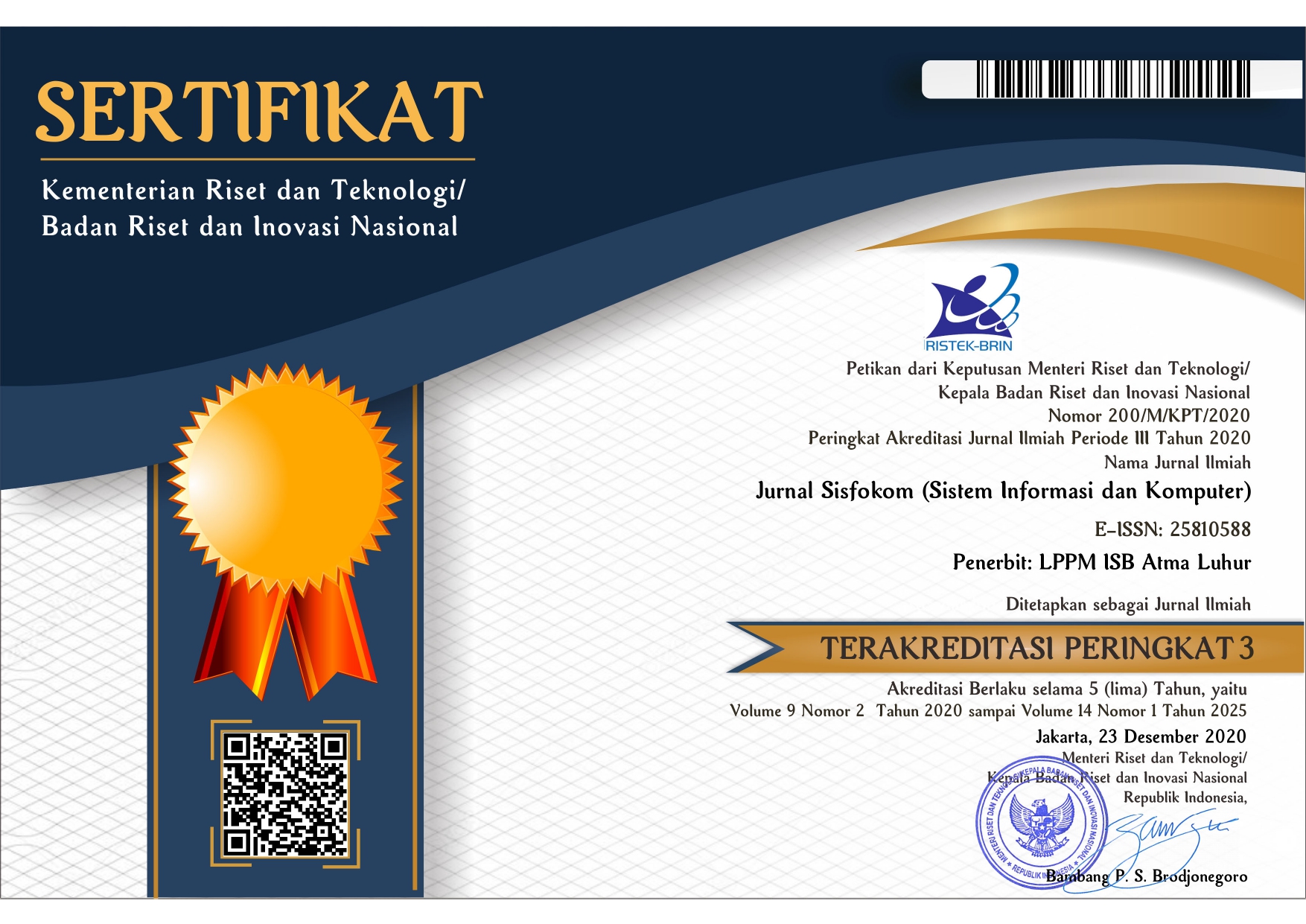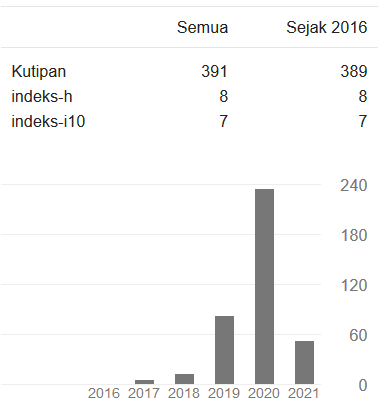Comparison of Monthly Rainfall Prediction using Long Short Term Memory and Multi Layer Perceptron Methods in South Tangerang City
DOI:
https://doi.org/10.32736/sisfokom.v13i2.2149Keywords:
rainfall, prediction, LSTM, MLPAbstract
Rainfall is one of the meteorological and climatological parameters whose information must be disseminated to the public and related stakeholders. Rainfall information has an important role in the sectors of people's lives. In agriculture, the amount of rainfall has an important role in determining the planting season, so that this can prevent potential crop failure. On Disaster, South Tangerang City during the 2016-2021 period experienced floods, landslides, and droughts. Therefore, the importance of rainfall prediction information can improve meteorological and climatological information services in various sectors. Nevertheless, it is still difficult for the community and stakeholders to get monthly rainfall predictions with high accuracy in the long term. In this research, monthly rainfall prediction is designed using MLP (Multi Layer Perceptron) and LSTM (Long Short Term Memory). The data used is the monthly rainfall data of Climate Hazards Group InfraRed Precipitations (CHIRPS) for 42 years (period 1981-2022) with coordinate boundaries according to the research location, namely South Tangerang City, which is located between 106.625 º - 106.825 º East and 6.4 ° - 6.2 ° LS as many as 16 grids with a resolution of 0.05 ° each grid. Monthly rainfall prediction using MLP produces an RMSE value of 90.19, and a MAPE of 40.55, while the LSTM method produces an RMSE value of 88.12 and a MAPE of 40.49. Monthly rainfall prediction results using the LSTM method are better than the MLP method; this can be seen from the RMSE value of the LSTM method is smaller than MLP.References
Herlina, N., & Prasetyorini, A. (2020). Pengaruh Perubahan Iklim pada Musim Tanam dan Produktivitas Jagung (Zea mays L.) di Kabupaten Malang (Effect of Climate Change on Planting Season and Productivity of Maize (Zea mays L.) in Malang Regency). Jurnal Ilmu Pertanian Indonesia (JIPI), Januari, 25(1), 118–128. https://doi.org/10.18343/jipi.25.1.118
Sainstek, J., & Pekanbaru, S. (2021). SAINSTEK (e-Journal) Analisis Kondisi Atmosfer Saat Banjir dan Tanah Longsor (Studi Kasus : Nganjuk, 14 Februari 2021) INFORMASI ARTIKEL ABSTRACT.
Funk, C.C., Peterson, P.J., Landsfeld, M.F., Pedreros, D.H., Verdin, J.P., Rowland, J.D., Romero, B.E., Husak, G.J., Michaelsen, J.C. and Verdin, A.P., 2014. A quasi-global precipitation time series for drought monitoring. US Geological Survey data series, 832(4), pp.1-12.
Huang, X., Gao, L., Crosbie, R. S., Zhang, N., Fu, G., & Doble, R. (2019). Groundwater recharge prediction using linear regression, multi-layer perception network, and deep learning. Water (Switzerland), 11(9). https://doi.org/10.3390/w11091879.
Wibawa AP, Utama AB, Elmunsyah H, Pujianto U, Dwiyanto FA, Hernandez L. Time-series analysis with smoothed Convolutional Neural Network. Journal of big Data. 2022 Apr 26;9(1):44.
Prasetyo B, Pusparini N. Pemanfaatan SATAID Untuk Analisa Atmosfer di Wilayah Perairan. Jurnal Fisika dan Aplikasinya. 2018 Jun 1;14(2):37-44.
Kafara Z, Rumlawang FY, Sinay LJ. Peramalan Curah Hujan Dengan Pendekatan Seasonal Autoregressive Integrated Moving Average (Sarima). Barekeng: Jurnal Ilmu Matematika dan Terapan. 2017 Mar 1;11(1):63-74.
Bilgili M, Sahin B. Comparative analysis of regression and artificial neural network models for wind speed prediction. Meteorology and atmospheric physics. 2010 Nov;109:61-72.
Lin Z, Feng J, Lu Z, Li Y, Jin D. Deepstn+: Context-aware spatial-temporal neural network for crowd flow prediction in metropolis. InProceedings of the AAAI conference on artificial intelligence 2019 Jul 17 (Vol. 33, No. 01, pp. 1020-1027).
Szandala, Tomasz. (2021). Review and Comparison of Commonly Used Activation Functions for Deep Neural Networks. In Bio-inspired Neurocomputing, 203-224. Springer, Singapore
Sahu RK, Müller J, Park J, Varadharajan C, Arora B, Faybishenko B, Agarwal D. Impact of input feature selection on groundwater level prediction from a multi-layer perceptron neural network. Frontiers in Water. 2020 Nov 19;2:573034.
Downloads
Additional Files
Published
Issue
Section
License
The copyright of the article that accepted for publication shall be assigned to Jurnal Sisfokom (Sistem Informasi dan Komputer) and LPPM ISB Atma Luhur as the publisher of the journal. Copyright includes the right to reproduce and deliver the article in all form and media, including reprints, photographs, microfilms, and any other similar reproductions, as well as translations.
Jurnal Sisfokom (Sistem Informasi dan Komputer), LPPM ISB Atma Luhur, and the Editors make every effort to ensure that no wrong or misleading data, opinions or statements be published in the journal. In any way, the contents of the articles and advertisements published in Jurnal Sisfokom (Sistem Informasi dan Komputer) are the sole and exclusive responsibility of their respective authors.
Jurnal Sisfokom (Sistem Informasi dan Komputer) has full publishing rights to the published articles. Authors are allowed to distribute articles that have been published by sharing the link or DOI of the article. Authors are allowed to use their articles for legal purposes deemed necessary without the written permission of the journal with the initial publication notification from the Jurnal Sisfokom (Sistem Informasi dan Komputer).
The Copyright Transfer Form can be downloaded [Copyright Transfer Form Jurnal Sisfokom (Sistem Informasi dan Komputer).
This agreement is to be signed by at least one of the authors who have obtained the assent of the co-author(s). After submission of this agreement signed by the corresponding author, changes of authorship or in the order of the authors listed will not be accepted. The copyright form should be signed originally, and send it to the Editorial in the form of scanned document to sisfokom@atmaluhur.ac.id.









